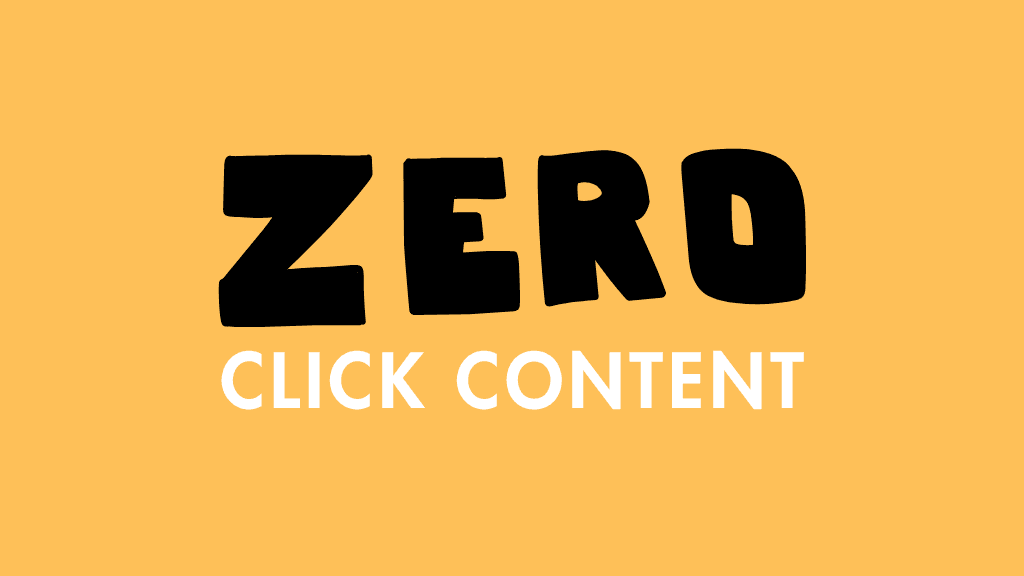
In this post I explore the concept of zero click content, outline its benefits, and show you how to go about creating it.
In July I attended the excellent Turing Fest in Edinburgh — a conference aimed at helping tech startups grow. It featured a host of insight-packed presentations relating to building, developing and leading online businesses, and I got a lot of value out of it.
But the presentation that got me thinking the most about the future of Style Factory — and indeed the future of businesses owned by our readers — was the one given by Rand Fishkin (Founder of Moz Pro and SparkToro) on the rise in significance of zero click content, and the increasing importance of zero click marketing.

In his presentation, Fishkin highlighted the growing number of Google searches that end without a click (around 60%).
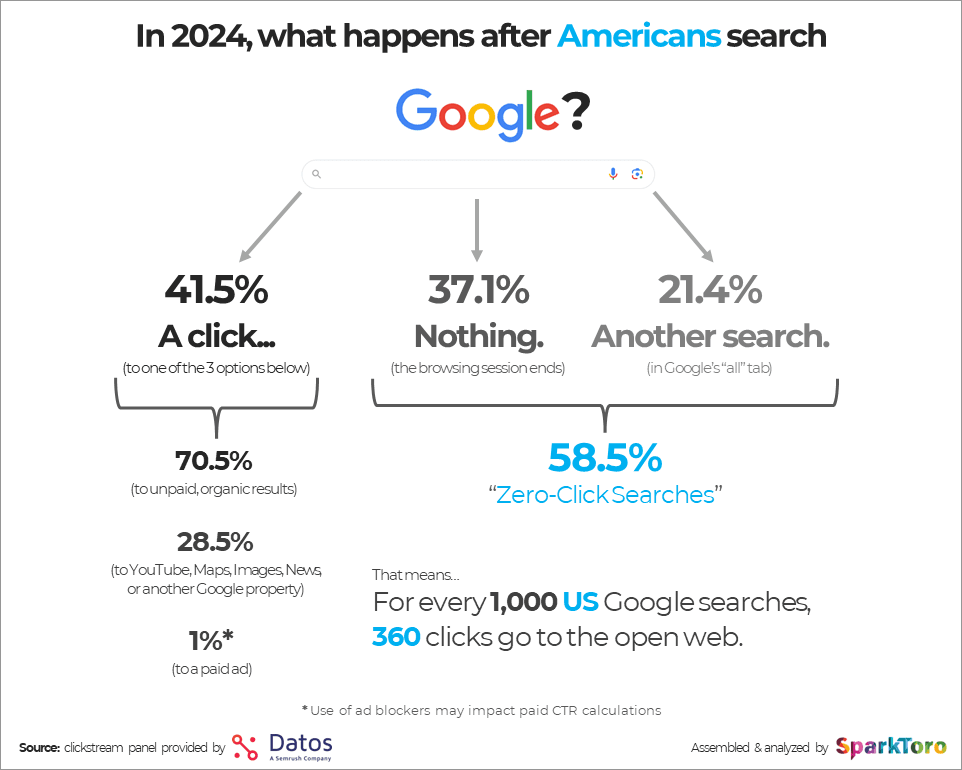
These zero click searches arise because Google is increasingly focusing on keeping users within its ecosystem, delivering information directly in search engine results through SERP features like…
- AI overviews — AI generated responses to queries (based on content found in Google’s index).
- Featured snippets — direct answers to questions at the top of the results page (pulled from authoritative websites).
- Knowledge panels — information about entities (like people or companies) displayed in a side panel.
- People Also Ask boxes — a list of related questions accompanied by immediate answers to them.
- Local map packs — business listings with reviews, hours and contact details.
- Live updates — realtime information on sporting and political events.
There are other things that Google is doing that are reducing the chances of getting a click from search results, too. Over the past few months, you may have noticed considerably more aggressive positioning of sponsored content in Google — to the point where in many cases, organic results are now displayed completely below the fold (underneath numerous sponsored results that are now barely distinguishable as ads).
This obviously has massive implications for anyone engaged in the business of search engine optimization, or businesses that rely heavily on organic search traffic. There is consistently less of it to go round.
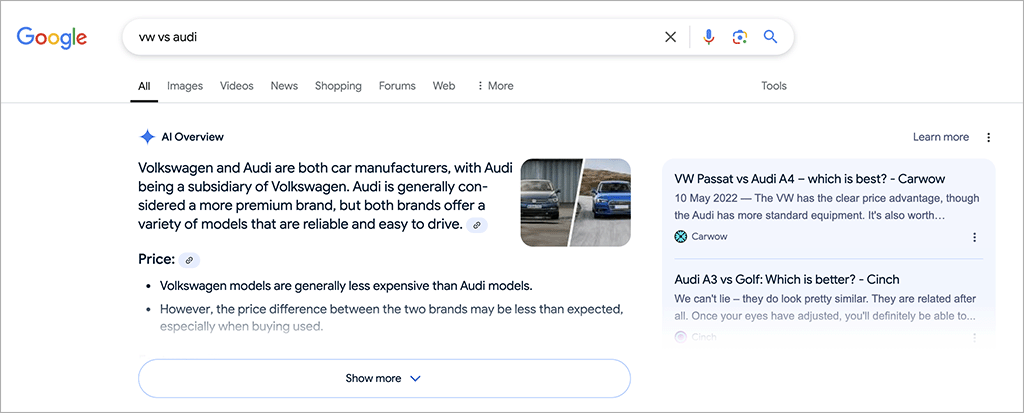
But Google is not the only platform killing clicks
If all that sounded grim, it gets worse! And this is — as Fishkin highlighted elsewhere in his presentation — because Google is not the only platform that doesn’t want you heading elsewhere.
All the big players are trying to stop users going anywhere:
- Facebook and LinkedIn’s algorithms don’t show posts containing external links as much as they show ‘native’ content (i.e., longer form posts or videos that don’t involve links).
- Instagram won’t let you include a link in a post at all (hence all those encouragements to ‘click the link in bio’).
- YouTube often asks you if you really want to follow that link to an external website — making you feel dubious about the link destination.
Fishkin’s table below highlights just how much search and social media giants are trying to keep you from ever leaving their platforms.
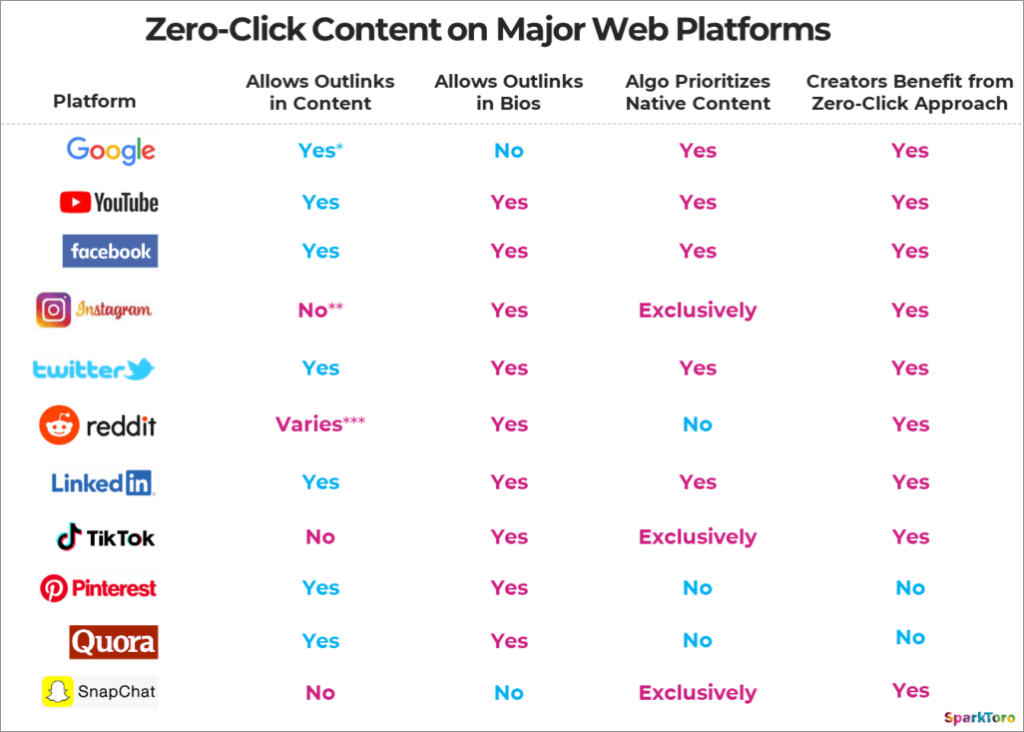
In short, most of the major platforms are doing their best to kill clicks. And it’s easy to see why: the more people staying on a platform, the more eyeballs that platform can get on ads (with all the monetization possibilities that brings).
So clicks to the ‘open web’ — i.e., to business websites — are reducing considerably, which obviously has significant financial implication for those businesses.
It’s not just clicks that are dying, it’s attribution too…
And to complicate matters even further, it’s getting harder and harder to attribute the traffic you do get. This, according to Fishkin, is for a few reasons:
- Apple ending its support for third-party cookie support within Safari.
- The proliferation of anti-tracking and data protection laws (think GDPR, CCPA etc.) and the accompanying rise in cookie banners.
- Massive uptake in ad blocker software usage.
- Multi-device journeys that make it harder to see where a referral begins and ends.
- The tendency for mobile apps and social networks to hide referral data.
All this leaves marketers in the dark. They increasingly don’t know how to get clicks, and they don’t know where the clicks they do get come from.
So what’s the answer?
Well, according to Fishkin and his colleagues, there are basically two things that marketers need to do to thrive in a world of less clicks and attributions.
The first is to focus on audience research: to find out where the kind of people you want to talk to are hanging out, and what they want to hear. In other words, rather than obsessing about where people found out about you after the fact (via attribution), think about where they might find you in the first place.
Now in many ways this emphasis on audience research from Fishkin isn’t surprising: he makes software (SparkToro) that lets you do precisely that! But there are other tools you can use in various ways to find audiences, for example Semrush, Answer The Public, Brand24 and SimilarWeb.
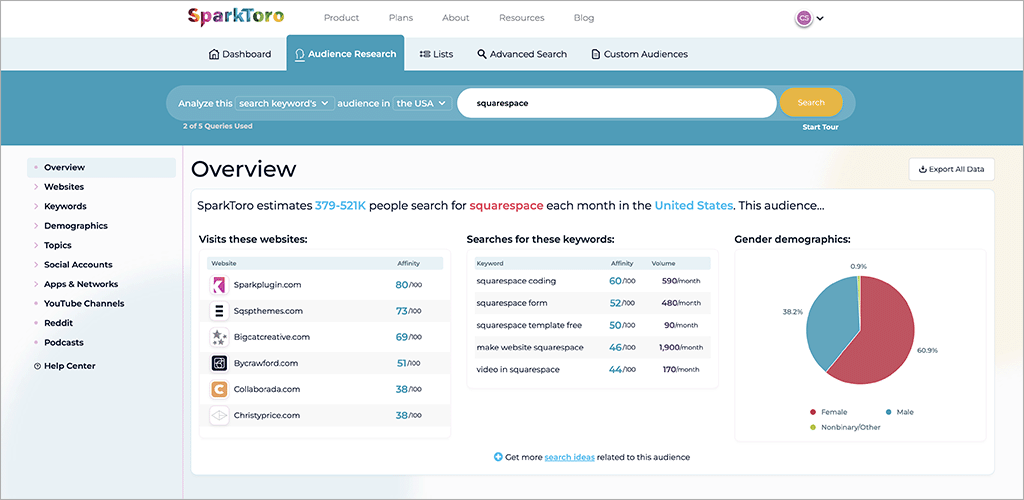
The next thing to do is create extremely good zero click content.
Creating zero click content means producing highly relevant, super high quality content that solves your audience’s problems — but without giving anybody a need to leave the platform they’ve encountered it on.
This might entail…
- Crafting an informative long-form blog post for your LinkedIn followers, but publishing the whole thing natively on the platform (rather than directing your audience to an external website).
- Giving your X followers a link-free thread containing a series of ‘how-to’ steps that address a common pain point.
- Using an Instagram Reel or a YouTube Short to explain a key concept in under a minute.
- Creating a comprehensive Google Business profile that gives people a really detailed, immediate overview of your business type, location and the best way to get in touch.
- Producing web pages in a way that maximizes the chances of content from them appearing as featured snippets in Google.
- Sending your mailing list subscribers a newsletter that contains a full article within the email itself (i.e., rather than a link to long form content elsewhere).
The benefits of all this to the user are clear. They receive content that’s geared towards them; packaged in a clear way; and hassle-free to access.
But what are the benefits of zero click content to businesses? Surely answering everything all in one place and never directing people to a website means no opportunity for lead generation or sales?
Well, the key advantage of this approach lies in the brand-building opportunities it generates.
If your content is seen by your potential customers on the platform they use the most, and it engages them and answers their queries in a really helpful way, they are more likely to form a good opinion about your brand.
And if they engage with this content in a positive way (via likes, shares or long dwell times), they are likely to encounter your brand on that platform again, thanks to algorithms rewarding your content and encouraging those consuming it to watch more of it (or follow your business on the platform).
After a while, this virtuous circle can lead to people searching for your brand on Google and then exploring the content on your platform (at which point you do have the opportunity to capture leads or sell products).
And when those users search for your brand on Google, you may get a secondary benefit: improved search rankings. There’s a school of thought, backed up by studies, that recent Google updates are giving preferential treatment to sites that are navigated to via branded searches.
(So in a weird way, could zero click content conceivably lead to more clicks?!)
📚Related resource: Overcoming Google’s Helpful Content Update with branded search
So does all this mean that SEO is dead, and we should stop posting links?
No. There are about 8 billion Google searches per day, so still plenty of opportunities to get organic clicks. And it’s ultimately in Google’s interest to keep providing content creators with organic traffic — otherwise those creators will have no incentive to produce content. And without that, there’s no real point to Google (and no fresh material to create those ‘instant answer’ AI overviews with either).
So my view is that we will still have, for the forseeable future at least, opportunities to get clicks on Google.
Similarly, social media platforms do still let you post links. Okay, so posts containing them are not surfaced as much as we might like — but, particularly if you have a large following, there is still unquestionably value in posting links to content on social profiles and pages. Doing so will still generate traffic.
And despite challenges, attribution is still a thing. At Style Factory, we can still see — clearly — which platforms are driving traffic to our site (and those of our clients), and what blog posts generate the most conversions. We may have less attribution data than before — but still plenty to go on.
But there’s no denying that there is a shift of direction going on, and the data that Fishkin and others are presenting about the decline of clicks and attribution is compelling — and shouldn’t be overlooked. Accordingly, it makes a lot of sense to consider making zero click content a key part of your marketing mix sooner rather than later, and to keep a close eye on how this whole area is developing.
To that end, I’ll leave you with a few top tips on how to go about zero click marketing. Good luck with avoiding those clicks!
Zero click marketing campaigns — our top tips
To succeed in a world of less clicks and attributions, businesses need to shift their focus to delivering value where users are already engaging. Here are a few steps you can take to do just that:
1. Find out where your audience hangs out
The first thing to do when planning a zero click marketing campaign is to find out where your audience is located — and what sort of content they like. What platforms do your potential customers use? What format appeals to them? Doing this typically involves using dedicated audience research tools — SparkToro, Similarweb, Brandwatch etc.
2. Optimize for featured snippets and SERP features
Featured snippets, knowledge panels, AI Overviews and People Also Ask boxes are prime zero click real estate on Google. Here’s how to optimize your content for them:
- Identify key questions: use tools like Ahrefs, Semrush or Moz to find the most common questions your target audience is asking.
- Structure your content properly: write clear, concise answers to these questions, using headers, lists and bullet points to increase the likelihood of your being featured in a snippet. And answer these questions as directly as possible.
- Use Schema markup: implement structured data on your site to help search engines understand your content better and display it as rich results. FAQs, reviews, and product information are all examples of content that can benefit from schema markup.
3. Create engaging zero click content on social media platforms
On social media platforms, zero click content is about building engagement without pushing users off the platform. Here’s how to do that:
- Produce great native content: create engaging videos, infographics and carousels that provide immediate value to your audience. The goal here is to deliver useful information or entertainment without needing to link to external content.
- Encourage engagement: structure your content in a way that is likely to maximize engagement — either in terms of the total amount of interaction time, or the likes and comments it receives. You can encourage the former through compelling storytelling and the latter by invitations to interact with your content in a particular way.
4. Optimize for voice search
More and more people now rely on ‘click-free’ voice assistants like Siri, Alexa, and Google Assistant — potentially making optimizing for voice search a key part of zero click marketing. To boost your chances of being surfaced by a voice search,
- Use conversational keywords: optimize for long-tail, question-based keywords that mirror how people actually speak when using voice search.
- Provide direct answers: ensure your content answers questions clearly and concisely — in a format that will lend itself well to a voice search response to a user query.
5. Take full advantage of your Google Business profile
Google Business profiles are often a key provider of important click-free information (especially where local businesses are concerned) — users can get your business details, reviews and contact information directly from them. To maximize the usefulness and visibility of your Google Business profile, you should do the following:
- Ensure accurate information: keep your business details up to date — provide comprehensive, accurate information about your address, hours of operation, and contact info.
- Encourage reviews: positive reviews can help improve your visibility in local search results and build trust with potential customers.
- Post Q&A: provide answers to common customer questions directly within your Google Business profile — doing so can provide users with a lot of value without requiring them to click anything.
Comments (2)
This was very informative — thanks Chris. Organic search through Google is by far the main source of traffic to our website (we do not currently use paid ads) and even if we are not yet seeing a drop in traffic to our site, we intuitively know that the way people search for information is changing, even based on our own personal experience (I increasingly find myself not clicking on links in search results). Zero-click content is counter-intuitive but also intriguing — your article is very helpful — it not only explains what’s going on but also gives us tips to help us negotiate this change. Thanks again!
Cheers for the feedback David. Yes it’s a strange world we find ourselves in now! We have relied on organic search traffic for a long time now, but because of the way things are trending, we are also exploring other platforms for our content (especially LinkedIn and YouTube). This is because not only are these platforms searchable by users, they automatically surface content based on interests etc. too.